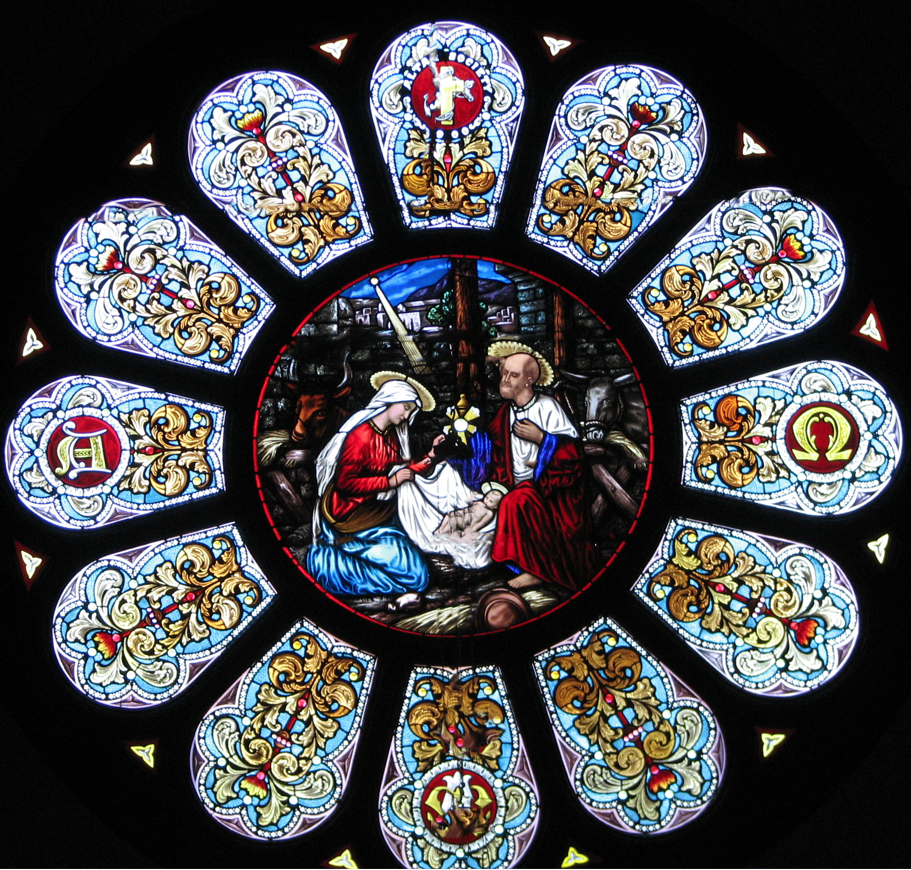Rose window illustrates Nativity at Menlo Park church
By Mary Powers
Assistant Director of Communications, Archdiocese of San Francisco

Each year, parishioners at the Church of the Nativity in Menlo Park arrive to midnight Mass in the dark of night to see a great light. The church is unlit, illumined solely by the stained-glass rose window of the Nativity – a reminder of the joy of that first Christmas when Christ, the light of the world, was born in a humble stable.
Given to the parish in 1900 by the parish altar society, not much more is known of its origins or the artist who designed it, but it is presumed to have been made in the United States.
What we do know is that the window is full of the symbolism of the season and also a reminder of Christ’s crucifixion, the reason for his coming into the world.
The window itself is a rose window – a circular stained-glass window with a center image and radiating tracery resembling a flower with petals. Rose windows reached their height in high Gothic architecture in the 13th century and can be found in churches across the world, most famously in Notre-Dame de Paris Cathedral and Chartres Cathedral in France.
“It’s a representation of the Nativity,” explained Msgr. Steven Otellini, pastor of the Church of the Nativity, but the window’s illustration conflates several Gospel accounts. “In Luke’s account, we have the details of the birth in Bethlehem in a stable, and in Matthew’s account we have the visit of the Magi with the star. So it has both of those combined together. It is Matthew’s star with Luke’s stable.”
The Virgin Mary and St. Joseph kneel in prayer before the Christ Child, traditionally rendered as a young Mary and an older St. Joseph. The red and blue of Our Lady’s tunic and veil represent the red of her martyrdom at the foot of the cross and the blue identifies her as a daughter of Israel. Not much is known of the colors chosen for St. Joseph, but the purple may signify the royalty of his family as descendants of King David. St. Joseph’s hat can also be seen at the bottom of the inner circle.
Next to Our Lady is placed a pouch of salt. It was a custom for the Jewish people at the time to rub salt on newborns for hygienic purposes as well as to keep away and drive out demons, a precursor to the blessed salt of today, Msgr. Otellini explained.
The animals, too, play a part in the iconography of the window. The use of an ox and an ass, or donkey, in Christmas scenes can be found in the oldest medieval renderings. The scriptural references to animals and the Nativity can be found in the first chapter of Isaiah, which states, “An ox knows its owner, and an ass its master’s manger; But Israel does not know, my people has not understood” (Is 1: 3). The reference to biblical animals is also found in the third chapter of the relatively unknown book of the prophet Habakkuk, which prophesies that the Messiah will be manifest between two animals, Msgr. Otellini said.
The ox represents the Jewish people: just as an ox is yoked in its work, so, too, the people of Israel carry the law given to them by God. The donkey is a representation of the gentile people, and together, both illustrate Christ’s mission to free all from the slavery of sin, the pastor of the Menlo Park parish explained.
The pastoral scene also has imagery foretelling the death Christ would endure, reminding the faithful of the reason for his birth. Behind the stable lies the city of Jerusalem, and there is a hidden cross built into the structure of the manger.
The tracery around the center window includes 12 windows with rich symbolism: the Greek letters of alpha and omega, representing Christ as beginning and end; a cross with an anchor symbolizing the hope of the cross; and the letters AM for Ave Maria. Twelve is a biblical number associated with the 12 tribes of Israel and the 12 apostles.
As the Church of the Nativity begins its 150th anniversary year, the centerpiece stained-glass window holds the heart of the Gospel – that Christ was born on earth to save us from our sins, freeing us from death. Come, let us adore him!

